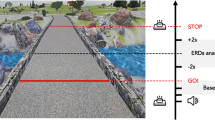Abstract
Motor imagery (MI) is widely used to study cognitive aspects of the neural control of action. Prior studies were mostly centred on hand and arm movements. Recently a few studies have used imagery tasks to explore the neurophysiology of human gait, but it remains unclear how to ascertain whether subjects actually perform imagery of gait as requested. Here we describe a new experimental protocol to quantify imagery of gait, by behaviourally distinguishing it from visual imagery (VI) processes and by showing its temporal correspondence with actual gait. Fourteen young healthy subjects performed two imagery tasks and an actual walking (AW) task. During both imagery tasks subjects were sitting on a chair and faced a computer screen that presented photographs of walking trajectories. During one task (MI), subjects had to imagine walking along the walking trajectory. During the other task (VI), subjects had to imagine seeing a disc moving along the walking trajectory. During the AW task, subjects had to physically walk along the same walking trajectory as presented on the photographs during the imagery tasks. We manipulated movement distance by changing the length of the walking trajectory, and movement difficulty by changing the width of the walking trajectory. Subjects reported onset and offset of both actual and imagined movements with a button press. The time between the two button presses was taken as the imagined or actual movement time (MT). MT increased with increasing path length and decreasing path width in all three tasks. Crucially, the effect of path width on MT was significantly stronger during MI and AW than during VI. The results demonstrate a high temporal correspondence between imagined and AW, suggesting that MI taps into similar cerebral resources as those used during actual gait. These results open the possibility of using this protocol for exploring neurophysiological correlates of gait control in humans.




Similar content being viewed by others
References
Bakker M, Bloem BR, de Lange FP, Toni I (2006) Neuroimaging of gait: an imagery approach. Neuroimage 31:S150 (Abstract)
de Lange FP, Hagoort P, Toni I (2005) Neural topography and content of movement representations. J Cogn Neurosci 17:97–112
Decety J (1991) Motor information may be important for updating the cognitive processes involved in mental imagery of movement. Eur Bull Cogn Psychol 11:415–426
Decety J, Jeannerod M (1995) Mentally simulated movements in virtual reality: does Fitts’s law hold in motor imagery? Behav Brain Res 72:127–134
Decety J, Michel F (1989) Comparative analysis of actual and mental movement times in two graphic tasks. Brain Cogn 11:87–97
Deiber MP, Ibanez V, Honda M, Sadato N, Raman R, Hallett M (1998) Cerebral processes related to visuomotor imagery and generation of simple finger movements studied with positron emission tomography. Neuroimage 7:73–85
Donders FC (1969) On the speed of mental processes. Acta Psychol (Amst) 30:412–431
Fitts PM (1954) The information capacity of the human motor system in controlling the amplitude of movement. J Exp Psychol 47:381–391
Guillot A, Collet C (2005) Contribution from neurophysiological and psychological methods to the study of motor imagery. Brain Res Brain Res Rev 50:387–397
Jahn K, Deutschlander A, Stephan T, Strupp M, Wiesmann M, Brandt T (2004) Brain activation patterns during imagined stance and locomotion in functional magnetic resonance imaging. Neuroimage 22:1722–1731
Jeannerod M (1994) The representing brain: neural correlates of motor intention and imagery. Behav Brain Sci 17:187–245
Johnson-Frey SH (2004) Stimulation through simulation? Motor imagery and functional reorganization in hemiplegic stroke patients. Brain Cogn 55:328–331
Lang W, Petit L, Hollinger P, Pietrzyk U, Tzourio N, Mazoyer B, Berthoz A (1994) A positron emission tomography study of oculomotor imagery. Neuroreport 5:921–924
Malouin F, Richards CL, Jackson PL, Dumas F, Doyon J (2003) Brain activations during motor imagery of locomotor-related tasks: a PET study. Hum Brain Mapp 19:47–62
Miyai I, Tanabe HC, Sase I, Eda H, Oda I, Konishi I, Tsunazawa Y, Suzuki T, Yanagida T, Kubota K (2001) Cortical mapping of gait in humans: a near-infrared spectroscopic topography study. Neuroimage 14:1186–1192
Parsons LM (1987) Imagined spatial transformation of one’s body. J Exp Psychol Gen 116:172–191
Parsons LM (1994) Temporal and kinematic properties of motor behavior reflected in mentally simulated action. J Exp Psychol Hum Percept Perform 20:709–730
Porro CA, Francescato MP, Cettolo V, Diamond ME, Baraldi P, Zuiani C, Bazzocchi M, di Prampero PE (1996) Primary motor and sensory cortex activation during motor performance and motor imagery: a functional magnetic resonance imaging study. J Neurosci 16:7688–7698
Pylyshyn ZW (2002) Mental imagery: in search of a theory. Behav Brain Sci 25:157–182
Roth M, Decety J, Raybaudi M, Massarelli R, Delon-Martin C, Segebarth C, Morand S, Gemignani A, Decorps M, Jeannerod M (1996) Possible involvement of primary motor cortex in mentally simulated movement: a functional magnetic resonance imaging study. Neuroreport 7:1280–1284
Sirigu A, Duhamel JR, Cohen L, Pillon B, Dubois B, Agid Y (1996) The mental representation of hand movements after parietal cortex damage. Science 273:1564–1568
Stephan KM, Fink GR, Passingham RE, Silbersweig D, Ceballos-Baumann AO, Frith CD, Frackowiak RS (1995) Functional anatomy of the mental representation of upper extremity movements in healthy subjects. J Neurophysiol 73:373–386
Stevens JA (2005) Interference effects demonstrate distinct roles for visual and motor imagery during the mental representation of human action. Cognition 95:329–350
Wilkinson D, Halligan P (2004) The relevance of behavioural measures for functional-imaging studies of cognition. Nat Rev Neurosci 5:67–73
Acknowledgments
This research was supported by the Internationaal Parkinson Fonds (to MB and BB). FPdL and IT were supported by the Dutch Science Foundation (NWO: VIDI grant no. 452-03-339).
Author information
Authors and Affiliations
Corresponding author
Rights and permissions
About this article
Cite this article
Bakker, M., de Lange, F.P., Stevens, J.A. et al. Motor imagery of gait: a quantitative approach. Exp Brain Res 179, 497–504 (2007). https://doi.org/10.1007/s00221-006-0807-x
Received:
Accepted:
Published:
Issue Date:
DOI: https://doi.org/10.1007/s00221-006-0807-x




